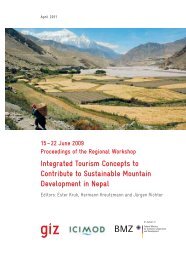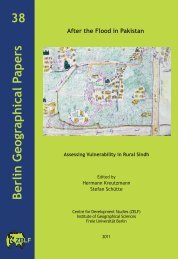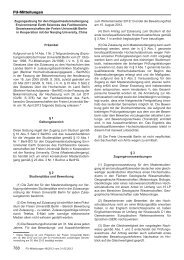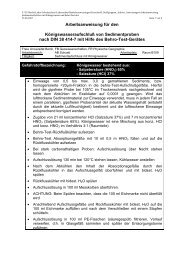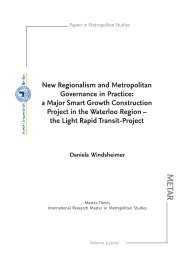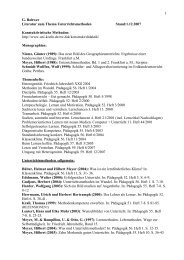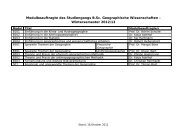Pastoralism and Rangeland Management on the Tibetan Plateau in ...
Pastoralism and Rangeland Management on the Tibetan Plateau in ...
Pastoralism and Rangeland Management on the Tibetan Plateau in ...
You also want an ePaper? Increase the reach of your titles
YUMPU automatically turns print PDFs into web optimized ePapers that Google loves.
For <strong>the</strong> pastoralism sector <strong>the</strong> collective ownership of livestock <str<strong>on</strong>g>and</str<strong>on</strong>g> <strong>the</strong> <strong>in</strong>troducti<strong>on</strong><br />
of permanent w<strong>in</strong>ter settlements were am<strong>on</strong>g <strong>the</strong> key features <str<strong>on</strong>g>and</str<strong>on</strong>g><br />
visible signs of a chang<strong>in</strong>g pattern of social organisati<strong>on</strong>. The formati<strong>on</strong> of<br />
collective work teams <str<strong>on</strong>g>and</str<strong>on</strong>g> producti<strong>on</strong> brigades <strong>in</strong>fluences <strong>the</strong> divisi<strong>on</strong> of labour<br />
<str<strong>on</strong>g>and</str<strong>on</strong>g> <strong>the</strong> specialisati<strong>on</strong> with<strong>in</strong> animal husb<str<strong>on</strong>g>and</str<strong>on</strong>g>ry practices. With <strong>the</strong>se reforms<br />
a slogan came up that was repeated <str<strong>on</strong>g>and</str<strong>on</strong>g> kept alive for nearly two decades: “take<br />
gra<strong>in</strong> as a key l<strong>in</strong>k” (yi liang wei gang) which dur<strong>in</strong>g <strong>the</strong> cultural revoluti<strong>on</strong><br />
(1966–1976) – <strong>the</strong> subsequent major <strong>in</strong>terventi<strong>on</strong> phase – resulted <strong>in</strong> a “gra<strong>in</strong><br />
first” policy. Repeatedly, analysts have <strong>in</strong>terpreted <strong>the</strong>se <strong>in</strong>terventi<strong>on</strong>s as a<br />
strategy to exp<str<strong>on</strong>g>and</str<strong>on</strong>g> crop farm<strong>in</strong>g at all costs <str<strong>on</strong>g>and</str<strong>on</strong>g> at <strong>the</strong> cost of reduc<strong>in</strong>g animal<br />
husb<str<strong>on</strong>g>and</str<strong>on</strong>g>ry. Peter Ho has questi<strong>on</strong>ed this <strong>in</strong>terpretati<strong>on</strong> <str<strong>on</strong>g>and</str<strong>on</strong>g> warned aga<strong>in</strong>st<br />
tak<strong>in</strong>g it as a reducti<strong>on</strong> strategy: “From <strong>the</strong> very beg<strong>in</strong>n<strong>in</strong>g <strong>the</strong> full slogan ran:<br />
‘Take gra<strong>in</strong> as <strong>the</strong> key l<strong>in</strong>k for overall development <str<strong>on</strong>g>and</str<strong>on</strong>g> diversificati<strong>on</strong>’ (yi liang<br />
wei gang, quanmian fazhan, duozh<strong>on</strong>g j<strong>in</strong>gy<strong>in</strong>g). This slogan was accompanied<br />
by ano<strong>the</strong>r: ‘Agriculture, forestry, <str<strong>on</strong>g>and</str<strong>on</strong>g> animal husb<str<strong>on</strong>g>and</str<strong>on</strong>g>ry are <strong>in</strong>terdependent;<br />
not <strong>on</strong>e can be omitted’ (n<strong>on</strong>g, l<strong>in</strong>, mu san zhe huxiangyilai; queyi bu ke)”. 42<br />
He emphasises <strong>the</strong> respective <strong>in</strong>terventi<strong>on</strong>s <strong>in</strong> all sectors <strong>in</strong>clud<strong>in</strong>g animal<br />
husb<str<strong>on</strong>g>and</str<strong>on</strong>g>ry as a strategy to enhance food security for society. Very restrictive approaches<br />
that had significant flaws <str<strong>on</strong>g>and</str<strong>on</strong>g> caused severe problems are menti<strong>on</strong>ed<br />
here <strong>on</strong>ly for <strong>the</strong> purpose of <strong>the</strong>ir collective properties that established collective<br />
ownership of livestock <str<strong>on</strong>g>and</str<strong>on</strong>g> productive <strong>in</strong>frastructure. The “ir<strong>on</strong> rice bowl” as<br />
a system of food security for <strong>the</strong> general public was envisaged, but productivity<br />
rema<strong>in</strong>ed low.<br />
42 Ho 2003: 50.<br />
213<br />
> > > 5. Pastoral Practices <str<strong>on</strong>g>and</str<strong>on</strong>g> <strong>the</strong>ir Transformati<strong>on</strong>s



